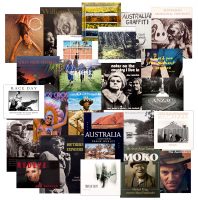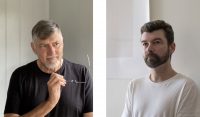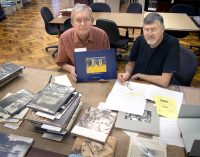
Image: Australian & New Zealand Photobooks
52 Antipodean Photobooks for Tate: Doug Spowart interviewed by Kristian Häggblom
24.2.21
To celebrate PHOTO 2021's Photobook Weekend, Dr Kristian Häggblom interviewed Doug Spowart about his interest in photobooks and the 52 Australian and New Zealand photobooks that were selected to enter the collection at the Tate.
In 2019 Doug Spowart and Victoria Cooper completed a project relating to the compilation of 52 Australian and New Zealand photobooks from the post WWII to early 2000s period for Tate Britain. The books were intended to compliment the Australian and New Zealand component of the 12.5k Martin Parr photobook collection that he was about to donate to the Tate. Martin Parr recommended Doug Spowart to the Tate after meeting him and attending a lecture presented by Spowart about the Antipodean Photobook at the Vienna Photobook Festival.
To see the titles of the 52 books and to connect with this project and other Antipodean photobook information visit the Antipodean Photobook Blog.

Image: Doug Spowart and Kristian Häggblom
Doug, your knowledge of Australian and New Zealand (ANZ) photobook publications is extensive and complex. When did you start collecting?
For me it all began in the early 1960s when as a boy I was given a subscription to National Geographic. Very quickly my interest moved through ‘how to do it books’ to a connection with the cult photographers of the time and their work. My interest in the photographer’s book had begun.
Since then I have read, purchased, collected, loaned books and, on occasion not given them back to their rightful owners because I couldn’t part with them. In time, a library grew from a bookshelf, to many bookcases and then to a room that subsequently overflowed. My partner Victoria Cooper and I continue this photobook folly…

Image: Martin Parr with Doug Spowart at the State Library of Victoria
Can you elaborate on some of the pleasures and pains of being commissioned by the Tate (and by extension Martin Parr) to curate the The Antipodean Photobook collection?
The answer to this question is intertwined with the pleasure of my long history in collecting photobooks from mainstream, antiquarian and second hand bookshops, Lifeline Book Fairs and online. The pain is related to the ephemeral nature of many small editions and self-publishing in Australia at that moment in time and our financial capacity to purchase books.
Our offer of books was also limited and defined by time constraints for the project and was made more painful as we have several thousand books, catalogues and ephemera to select from. Ultimately, the joy and pleasure lies in the fact that theselection is just the skeletal framework of what we hope will be fleshed out and added to in the coming years by the books we are still discovering in our ongoing research.
We believe that there are many more books where some are forgotten or obscured from general recognition but represent issues, have innovative design attributes or were precursors to subsequent documentary work. As such we have made contact with the Tate and they are prepared to accept any future donations of books we offer.
Beyond some obvious, although varied, attempts to define Australian and New Zealand culture visually, what are some other possible themes that link the books you choose?
We must emphasise that this selection is not meant to define but rather to stimulate a conversation as alluded to in your previous question. Important to us were books that addressed social, political, environmental and cultural space of Australia and New Zealand (ANZ). Where possible, we have selected works that have been identified by curators, historians and researchers for their prominence within the photographically illustrated and photobook publishing genres. Most importantly again it is just a beginning something that can be added to, challenged and reflected on. We do not impose themes and threads but in the diversity of the selection we hope to make the space for such to occur.
Of interest to us was to include books created and designed by women photographers. Interestingly, the oldest book in the collection is Olive McInerny’s Sturt and the Children’s Library. Most would know the photographer by her maiden name Olive Cotton. Her book was commissioned in 1946 by Winifred West, published and designed by Olga Sharp. It should be noted that Twelve of the 52 books were by women photographers.
We had selected, Wild Rivers by Peter Dombrovkis, but was ultimately not included as Parr did not think it fitted with the donation at this time. Although we were able to include many other books of an environmental theme in the final offer. Some of the following were also collaborations with poets: Only one kilometre by Joyce Evans and I. Turner; The language of oysters by Juno Gemes, Robert Adamson, John Kinsella; The silent land: a pictorial record of the West Coast of the South Island of New Zealand by Les Cleveland; River/Road: journeys through ecology by David Cook, W. Puke, J. Valentine; and Last Rivers Song by Lloyd Godman.
![Rennie_Ellis’ book Australian_Graffiti Image: Rennie Ellis’ book [Australian Graffiti]](https://photo.org.au/api/wp-content/uploads/2021/02/IMAGE-4-Rennie_ELLIS-Australian_Graffiti-1630px-200x86.jpg)
Image: Rennie Ellis’ book Australian Graffiti
Two of the photobooks feature toilets as subject matter. I'm interested in Rennie Ellis' Australian Graffiti as much of the text is fairly political, humorous and confrontation? Can you tell us a bit about this choice?
Rennie Ellis’ Australian Graffiti covers a period in the 1970s where graffiti became the voice for socio-political commentary. If you had an opinion that was not being heard you scrawled across walls in public spaces. The B.U.G.A. U.P. movement by defacing advertising also seemed to give permission for all kinds of messaging. Though Ellis’ documents also present the larrikin and yobbo scrawls in public lavatories. As you say the work was humorous and confronting and the book captured that moment in time which was to transition later into the more abstracted ‘hip-hop’ of the 1980s spraypaint tag. The book was reissued as Australian Graffiti Revisited and was published in 1979 and a sequel The all new Australian graffiti in 1985.
An interesting addition to the graffiti theme is Richard Tipping’s Signs of Australia which documents ‘found’ texts in the landscape that has provided Tipping with the inspiration for his ongoing word-play art signs and sculptures.
I'm also intrigued by Gerrit Fokkema's Wilcannia: portrait of an Australian town, especially as it would be viewed largely in a negative light if made today. Do you think there was much collaboration undertaken in its making, perhaps through lengthy and engaged periods of stay?
Interesting you say that… Gerrit spent a month in Wilcannia in 1982 connecting with the local community, gaining their acceptance and subsequently used opportunities to make portraits of the town’s people. I first came across this work while doing research at the National Gallery of Australia where they hold an album of 75 photographs and it transformed the way I thought about Wilcannia. Later I discovered that the book had been trade published.
In relation to his documentary process I am aware that in 2008 Fokkema revisited Wilcannia and created a new body of work reconnecting with those he had photographed before. This body of work was a featured exhibition at Head-On in 2017. Gerrit writes of his experiences in the dual documentation of Wilcannia:
If you only relied on the media and statistics to form an opinion of Wilcannia, the picture would be grim. … As you spend time in Wilcannia, however, a much richer and more nuanced story emerges. Wilcannia is a robust and vibrant community, where people are proud of their heritage and culture and are working to overcome the challenges they face with humour, dignity and solidarity.
Douglas Holleley Vision's of Australia is far more abstract approach to Australian urban/landscape? What drove this choice?
Holleley was a hero of mine from the late 1970s and early 1980s and our photographs were featured as part of the Festival of Sydney curated exhibitions.
When I encountered Visions of Australia I was presented a different way of recording the landscape as reconfigured multi-image mosaics using SX-70 and large format Polaroid. Even now this book and its design is visually intriguing and transformed the way photographs can communicate a visual narrative into a book form. Interestingly today the idea of the Australian ‘road trip’ in a VW Combi van may also resonate with contemporary photo practice.
Mark Strizic's Two Thousand Weeks is an interesting book concept that is often used in Japan, employing a photographer on the set of a film and then producing a publication. Do you know if this has been done much in our region?
The Two Thousand Weeks photo novel to my knowledge may have been a unique concept in Australia. However, I do have one other photo novel that was published in Australia by Adam Magazine called The Money Plot (1972) that tells a story in cartoon style with word clouds and photographs. Though it looks to be American in origin through clothing styles and narrative.
Perhaps there are some photobooks that have the narrative form of a movie flowing from one image to another. Gael Newton has suggested to me that Axel Poignant’s Piccaninny walkabout: a story of two Aboriginal children (1957) could fit into this genre.
I do have one other book from Japan that features an erotic narrative with all the rude bits covered by black circles.
More recently, the inclusion of the self in documentary projects has been discussed and examined, commonly referred to as a diaristc approach. But in this collection there are other earlier examples, such as: William Yang's Sadness, Richard Tipping's Signs of Australia and Bruce Connew On the way to an Ambush. The diaristic approach was evidently being used post WWII, any thoughts on why it has been more largely examined?
A good question that does need investigation further. To my way of thinking the diaristic approach has been a part of photobook publishing from the 1970s and at that time may have been influenced by many factors including the emergence of a growing recognition of photography as artistic expression which was part of the reasons behind the establishment of the Australian Centre for Photography.
Perhaps also was a growing awareness of trends in north American photography influenced by John Szarkowski, Director of Photography at the Museum of Modern Art, that include the New Topographics and Mirrors and Windows – an exhibition of American photography since 1960. In Mirrors and Windows exhibition he put forward the proposition that some photographs were ‘mirrors – reflecting a portrait of the artist who made it’. And that a contrary position was that photographs could also be ‘windows – through which one might better know the world’. Different photographers employed these positions in the work they produced.
While Szarkowski presented a speaking tour of Australia supported by the Australian Centre for Photography in 1974 four years before his Mirrors and Windows, exhibition there may have been an influence on Australian photographers and the books they published that led to the contemporary term diaristic.
I guess to answer this question a thorough review of a broad range of books is necessary.
![Mary Macpherson’s book New World Image: Mary Macpherson’s book [Old New World]](https://photo.org.au/api/wp-content/uploads/2021/02/IMAGE-5-Mary_Macpherson-New_World-1604px-200x60.jpg)
Image: Mary Macpherson’s book Old New World
Sense of Place and The South Island of New Zealand from the Road by Robin Morrison and Old New World by Mary Macpherson seem to capture some of New Zealand's vernacular and quirky landscapes, or what Tim Winton coined in the introduction to Martin Mischkuling's book Smalltown 'fugly' landscapes. Were there more publications that worked in this tradition?
We have a copy of Martin’s Smalltown book and in Winton’s introduction he adds to the ‘fugliness’ comment that this represents ‘… a quaint, proud, heroic and ironical aesthetic that makes do with what it has to hand’.
A large sector of all ANZ photobooks seems to adopt this viewpoint the origins of which may connect local photographers becoming aware of Szarkowski’s new-topographic movement.
New Zealand photographers in particular have a significant tradition in documenting their vernacular built environments and people. In the 52 books we selected included, as you say, Morrison, Macpherson and we could add John B. Turner’s Te Atatu me: photographs of an urban New Zealand village.
The Antipodean social 'underbelly' seems somewhat underrepresented, except for Ann Shelton's Redeye and Rennie Ellis and Wes Stacey’s Kings Cross Sydney: a personal look at the Cross, were there more books that documented the more rambunctious side of our culture?
The book Southern Exposure by David Beal with text by Donald Horne was a warts and all challenge to the positivist up-beat National Geographic style of Robert Goodman’s The Australians. Other books presenting a story outside the prosaic could include Robert Rosen’s Snap: a celebration of twenty years of social photography, which presents a wild romp in the glamour social party scene of Sydney. William Yang’s Sadness also presented a view into the gay culture and the impact of AIDS.
Again there so many more books needing to be unearthed so can be reconised, discussed and brought into prominence. As identified in the question on my pain….
![Carol Jerrems’ book A Book About Australian Women Image: Carol Jerrems’ book [A Book About Australian Women]](https://photo.org.au/api/wp-content/uploads/2021/02/IMAGE-6-Carol_Jerrems-A_Book_About_Australian_Women-2000px-157x200.jpg)
Image: Carol Jerrems’ book A Book About Australian Women
How many copies of Carol Jerrems’ photobook A Book About Australian Women do you own?
This is an interesting question about rarity. We once had two copies – the Tate has one of these now. The rarity of Jerrems and Virginia Fraser’s book is rather curious as at one time we put a call out to friends to see how many were out in what we call the ‘wild’. We received many responses – “yes I’ve got a copy, maybe two…!” When we advised them of the book’s rarity in the open market of between $1-2,000 they were quite surprised. Not bad for a book that sold in 1974 for a few dollars. The recognition of Jerrems in the Australian photography scene has of course increased the interest in this book. Few other photographers have this prominence – Rennie Ellis’ books are now significantly rising in value even though the numbers in the wild of his ‘Life’s a…” must exceed 1,000s.
What are your hopes for the future of the photobook in this region?
There was a time when you could buy a history of the Australian and perhaps the New Zealand photobook for a few dollars at a Lifeline book sale or second-hand bookshop. Now books from the mid to the latter part of the 1900s are gradually slipping from view. There is very little interest in them. Their age and patina from being in Boomer’s bookshelves since being purchased or from when they were received as gifts means that they are left in bookshops or sale tables and subsequently maybe pulped or destined for landfill.
Martin Parr’s need to source local knowledge of ANZ photobooks is indicative of the awareness gap that exists in the internationally photobook scene. Although nearly every country has a reference book about the significant photobooks of their region – the ANZ region has no such list.
In this selection of books for the Tate we have provided a view of a small segment of photobook publishing in Australia and New Zealand. What is needed now to preserve and recognise Antipodean photobook publishing history in the international context is the development of discussion, commentary and critical discourse.
Dr Kristian Häggblom is an artist, curator, photobook collector and academic whose interests include expanded modes of documentary making, photobook publishing and cross-cultural curation. He completed his undergraduate studies in 1997 (RMIT) and his PhD, titled Viewing Platforms, in 2014 (Monash University). He has worked extensively in Japan and is the Course Convener of the Master of Arts – Photography program at the Photography Studies College, Melbourne. His work has been exhibited internationally including Australia, Japan, America, India, Mexico and Switzerland. More recently, he curated the large-scale Centre for Contemporary Photography, Melbourne, exhibition Tsuka: An Exhibition of Contemporary Japanese Photography that was supported by the Japan Foundation and launched the image-text project Two Inadequate Voices.
Doug Spowart’s connection with photobook collection and research:
· The Photobooks that I collected initially informed my photography projects that were resolved as image sets and exhibitions however from the late 1980s I began making book-based works.
· As a teacher in tertiary education I introduced photobook projects in my student work outcomes from the late 1990s and 2000s.
· The continued building of this collection influenced higher part-time academic research throughout the 2000s that included a PhD in 2011 on Self-publishing in the digital age: the hybrid photobook. My interest in the connection of artists’ books with photobook production led to a Fellowship with the Australian Library of Art in 2015researching this topic.
· In 2014 we needed to downsize the library due to relocation and in one weekend we sold off 400 books from our international library. We now concentrate our activities mainly in ANZ photobooks and artists’ books based on photographs.